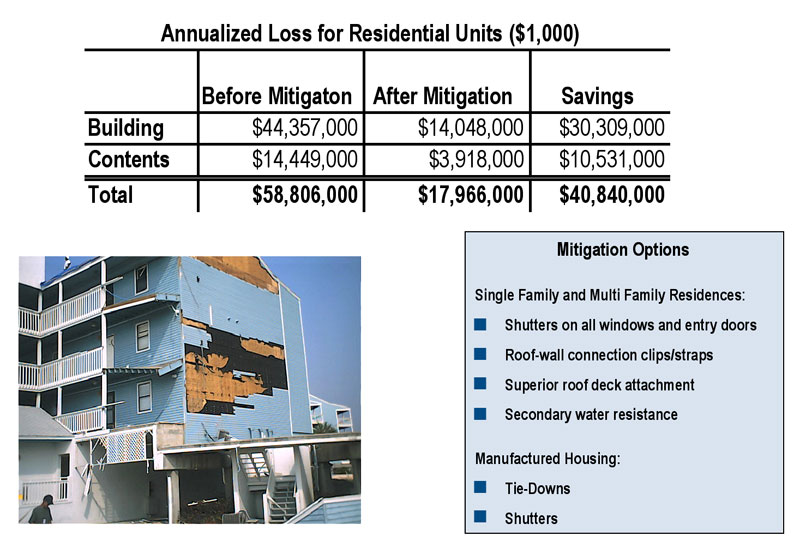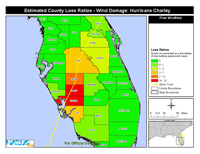Use of HAZUS-MH to Support Long-Term Community Recovery and Mitigation (ESF #14)
- Use of HAZUS to Estimate Losses Avoided Through Mitigation
- Losses Avoided from Select Mitigation Measures
- Hurricane Model Applications for ESF #14
- Application of Losses Avoided Analysis in SW Florida
- County Loss Ratios
Under the National Response Plan (NRP), Emergency Support Function #14 (ESF # 14) provides a coordination mechanism for the Federal government to assess the consequences of disasters and to coordinate the long-term recovery. ESF #14 is typically activated for large scale disasters that require Federal assistance to address significant long-term impacts on the affected area (including impacts on housing, business and employment, and community infrastructure). ESF #14 addresses three dimensions of recovery:
- Social and economic community impact assessment
- Long-term community recovery assistance to States, local governments, and the private sector
- Mitigation analysis and program implementation
HAZUS-MH has three core capabilities that can contribute to the implementation of ESF #14. HAZUS-MH can:
- Measure potential effects of consequences of a disaster.
- Simulate benefits and losses potentially avoided through the implementation of mitigation measures.
- Assess County Loss Ratios, which measures residential loss as a percentage of total residential building value.
Use of HAZUS to Estimate Losses Avoided Through Mitigation
HAZUS-MH can be a valuable tool in estimating damage and loss of functionality from floods, earthquakes, and hurricanes and the benefits from the implementation of select mitigation measures. The product of this analysis is estimates of losses avoided. Table 1 provides examples of losses avoided that can be estimated with HAZUS-MH from the implementation of various mitigation measures.
Losses Avoided from Select Mitigation Measures
| Damage/Loss Categories | Losses Avoided |
|---|---|
|
Physical Damage
|
Avoided physical damages |
|
Loss of Function / Economic Impacts
|
Avoided costs associated with loss of function |
|
Casualities
|
Avoided casualties |
|
Emergency Management Costs
|
Avoided costs associated with emergency services and cleanup |
Hurricane Model Applications for ESF #14
The HAZUS-MH hurricane model is particularly well suited to estimating losses avoided through the implementation of mitigation measures. The hurricane model incorporates the following mitigation options for Single Family Residential:
- Opening protection
- Roof covering
- Roof sheathing attachment
- Roof framing attachment
- Secondary water resistance
For Manufactured Homes, the hurricane model includes two mitigation options:
- Tie-Downs
- Shutters on all windows and entry doors
In 2003, FEMA sponsored a study to quantify the benefits of implementing select hurricane wind mitigation measures in South Florida. The results are shown on Table 2.
| Single Family Homes | Reduction in Annualized Hurricane Losses |
|---|---|
| Install Shutters | 17 percent to 46 percent |
| Upgrade Roof | 3 percent to 49 percent |
| Add Secondary Water | 3 percent to 35 percent |
| Resistance (SWR) | |
| Upgrade Roof and Add SWR | 4 percent to 57 percent |
| Install Shutters and Upgrade Roof | 46 percent to 71 percent |
| Install Shutters, Upgrade Roof and SWR | 51 percent to 85 percent |
| Manufactured Homes | |
| Foundation Tie Down | 9 percent to 25 percent |
Application of Losses Avoided Analysis in SW Florida
 In 2005, FEMA the Florida Division of Emergency Management sponsored the Southwest Florida HAZUS-MH Pilot Project. One of the objectives of the project was to identify and implement a series of projects and activities that demonstrate the capabilities of HAZUS-MH to support mitigation and disaster response.
In 2005, FEMA the Florida Division of Emergency Management sponsored the Southwest Florida HAZUS-MH Pilot Project. One of the objectives of the project was to identify and implement a series of projects and activities that demonstrate the capabilities of HAZUS-MH to support mitigation and disaster response.
The Mitigation Working Group used HAZUS-MH to prepare an analysis of losses avoided from hurricane wind damage – expressed as savings in annualized losses - from the implementation of mitigation projects. The study findings are highlighted in Figure 1.
County Loss Ratios
 A third use of HAZUS-MH for ESF #14 is analysis of County Loss Ratios.
A third use of HAZUS-MH for ESF #14 is analysis of County Loss Ratios.
During the 2004 and 2005 hurricane seasons, FEMA used HAZUS-MH to assess County Loss Ratios in Florida, Alabama and Mississippi. County Residential Loss Ratios measure residential loss as a percentage of total residential building value. A loss ratio greater than 5 percent signifies that a community has suffered extensive residential damage, when the damage is measured as a percentage of the total residential building value. This information helps in prioritizing and planning the long-term recovery activities. HAZUS-based benefit-analyses can then be used in support of decisions on identification of mitigation alternatives and priorities for the most seriously affected communities.
Figure 2 shows the results of the HAZUS-MH analysis of County Loss Ratios following Hurricane Charley in 2004. The analysis shows that Charlotte and Desoto counties have loss ratios that exceed 14 percent, which indicates severe residential damage, and should be targeted for Individual Assistance programs.
In summary, ESF#14 provides the coordination mechanisms for the Federal government to assess the consequences of the disaster in the impacted areas and to coordinate the long-term recovery. In this context, HAZUS-MH can be used to support post-disaster analysis, including assessments of:
-
Social and economic impacts;
-
Losses avoided from the implementation of mitigation measures;
-
Severity of residential damage, expressed as County Loss Ratios.
This information for the Use of HAZUS-MH to Support Long-Term Community Recovery and Mitigation is also available as a one-page handout in an alternative format.
-
Use of HAZUS-MH to Support Long-Term Community Recovery and Mitigation (PDF 1.0MB)
Download Plug-in
Some of the links on this page require a plug-in to view them. Links to the plug-ins are available below.
Last Modified: Monday, 29-Jan-2007 11:53:28 EST
